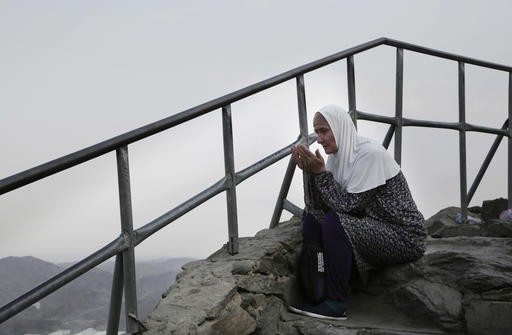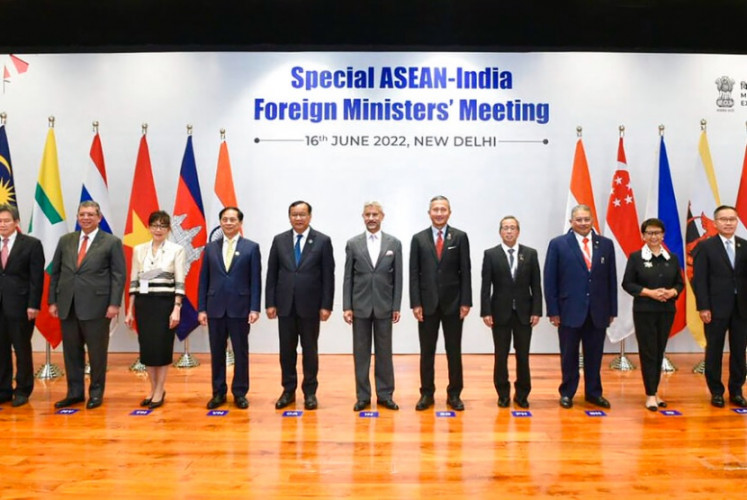Sacrifice without slaughtering?
Change Size
 Turkish woman prays on top of Noor Mountain, where Prophet Muhammad received his first revelation from God to preach Islam, on the outskirts of Mecca, Saudi Arabia, Friday, Sept. 9, 2016. Muslim pilgrims have begun arriving at the holiest sites in Islam ahead of the annual hajj pilgrimage in Saudi Arabia.
(AP Photo/Nariman El-Mofty)
Turkish woman prays on top of Noor Mountain, where Prophet Muhammad received his first revelation from God to preach Islam, on the outskirts of Mecca, Saudi Arabia, Friday, Sept. 9, 2016. Muslim pilgrims have begun arriving at the holiest sites in Islam ahead of the annual hajj pilgrimage in Saudi Arabia.
(AP Photo/Nariman El-Mofty)
O
n Idul Adha (the Islamic Day of Sacrifice), one of the two holiest days for Muslims, which this year falls on Sept. 12, Muslims will slaughter animals to commemorate Prophet Abraham’s willingness to sacrifice his son Ismail as an act of submission to God.
Slaughtering an animal during Idul Adha is also spiritually meant to be an act of piety, aimed at being closer to God — hence another name: Idul Qurban, which etymologically means, besides “offering”, “being close”.
However, the way the Idul Adha is marked today, at least in Indonesia, which has the world’s largest Muslim population, is different from in the past. There remain some concerns.
As the holiday draws nearer, the price of sacrificial animals (usually goats, sheep and cattle) increases significantly. Goats are priced at almost Rp 2 million (US$151) and cattle seven times as much.
These two animals are the cheapest, and the price is about 20 percent more than on regular days.
Idul Adha appears to have become a fertile business ground for many livestock animal traders.
This certainly has a relation to the high demand: with the growing middle class and Indonesia’s rapid economic growth, a lot of people nowadays can afford to buy the animals; some areas are even reported to experience livestock shortages.
Most importantly, this huge amount of money (imagine, across Indonesia, on average each village/subdistrict sacrifices dozens of animals) is spent to buy animals to be slaughtered just over the one to four days of Idul Adha, and its “benefit” lasts no longer than that.
Were that money to be spent on, say, educational endowment or any other thing for which the benefit lasted much longer, there would be a significant difference.
This should be of concern, more so considering that in past years there have people with more urgent needs than the selling the meat of sacrificial animals.
All this has much to do with the commonly held belief that slaughtering animals is of a purely ritual nature (ibadah mahdah), being mostly encouraged during Idul Adha, and therefore carried out in which the form of the ritual is as important, if not more so, as its substance or spiritual meaning.
This belief stems from the view still embraced by most Muslim scholars that the Idul Adha sacrifice cannot be replaced by cash alms; even for most people the sacrifice is limited only to animals such as goats, cattle, sheep or camels.
In fact, opinions vary in the traditional fiqh (Islamic jurisprudence). Yes, most classical fuqaha (fiqh experts) argue things as commonly believed.
Nonetheless, there is a minority position worth taking into account. It was narrated that a few companions of the Prophet such as Ibn Abbas and Bilal ibn Rabah slaughter sacrificial chickens because they believed that the symbolic part of the ritual was not the animals slaughtered but the act of slaughtering itself.
In other words, the essential part is the blood shedding, not the kinds of the animals.
This view was later embraced by some traditional fuqaha, such as al-Sha’bi and Abu Thaur, and it may have been also adopted by
Sunan Kudus, one of the legendary nine saints (Wali Sanga or the first propagators of Islam in Java), when he and his followers replaced cattle with buffalos for sacrifice out of respect for their Hindu neighbors.
Idul Adha appears to have become a fertile business ground for many livestock animal traders.
There is another view, which may have originated from modernist Muslims but to a certain degree has a basis in one of the sayings of Aisha, the youngest wife of the Prophet.
As reported by Ibn Qudamah (al-Mughni, 12/450), Aisha once said she preferred to give charity in the form of a valuable ring as a gift to Mecca citizens rather than slaughter 1,000 animals.
This view was once categorized as a contextualist approach by the late Kyai Ali Mustafa Ya’qub, former imam of the Grand Istiqlal Mosque in Central Jakarta.
Of the latest view, an objection might be posed: had giving alms in the form of cash been preferable to slaughtering animals during Idul Adha, the Prophet and his companions would have exemplified it.
A counter argument for this objection is that the social context at that time was significantly different from today.
At that time, animals were among the most valuable belongings that one could possess; maybe as valuable as a car for the people of today, and therefore people slaughtering animals for sacrifice were few.
Today is different, as aforementioned, besides the needs of contemporary people being much more than those of the past.
This is a proposal. At the end of the day, it is up to Muslim scholars themselves, because they hold the power to influence grassroots
Muslims.
There was recently an effort among Muslim scholars, which surprisingly came from the traditionalist school, to develop the so-called fiqh al-waqi’ or the fiqh of reality, a fiqh with a pragmatic approach that takes the contemporary social condition as one basis of jurisdiction.
The abovementioned contextualist view may fit that. A more fundamental scripturally grounded basis to enhance the argument may be cited, i.e. from the Quran (22:37) that reminds Muslims that “their meat will not reach God, nor will their blood; what reaches Him is piety from them.”
One last thing: apart from being more mindful of the longer-lasting benefit, this pragmatic approach may also be a basis for Muslims to have a more flexible dialogue with animal rights advocates.
____________________________________
The writer is a graduate student of the Center for Religious and Cross-Cultural Studies (CRCS), Gadjah Mada University, Yogyakarta.









